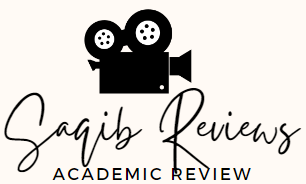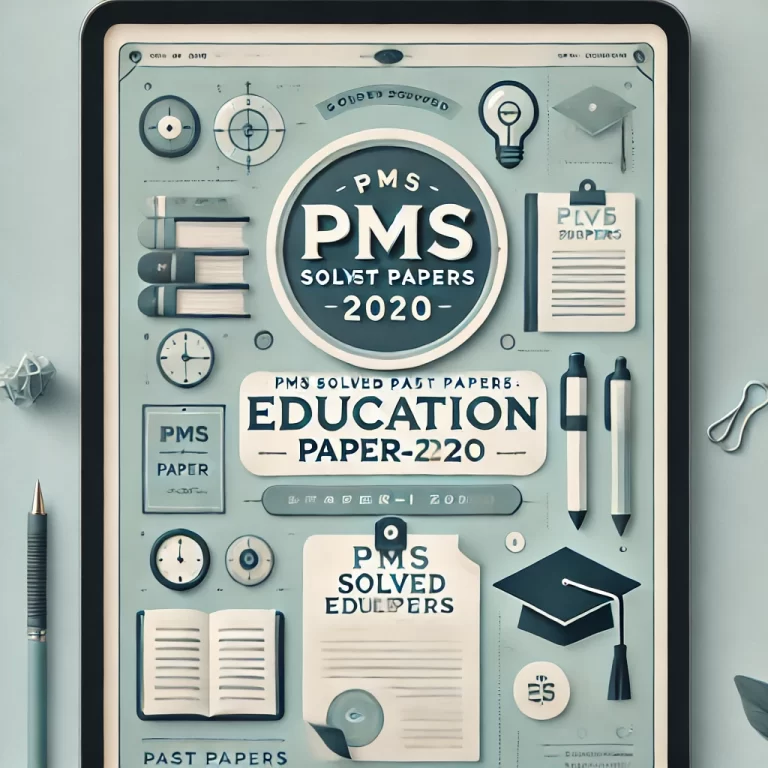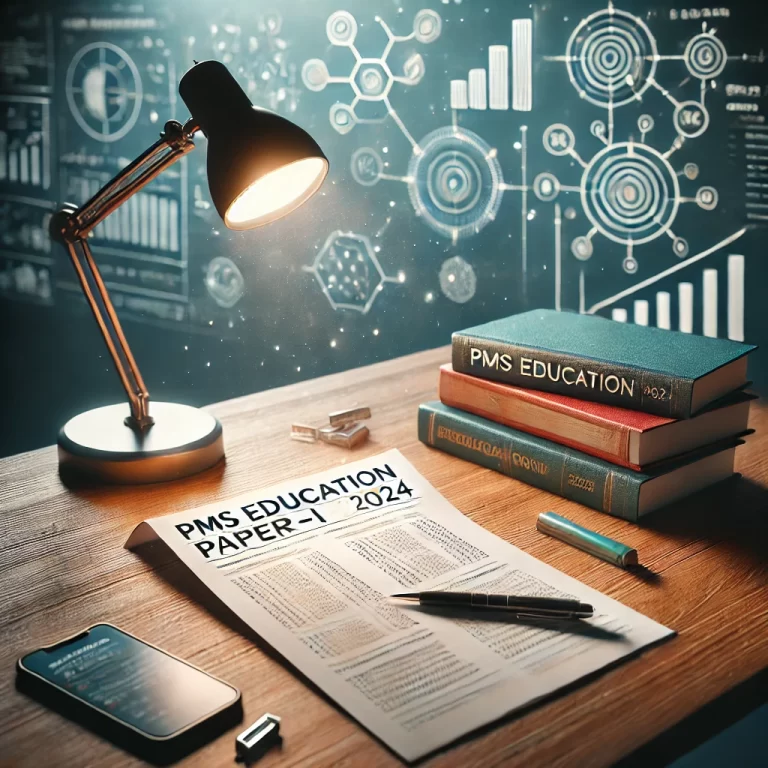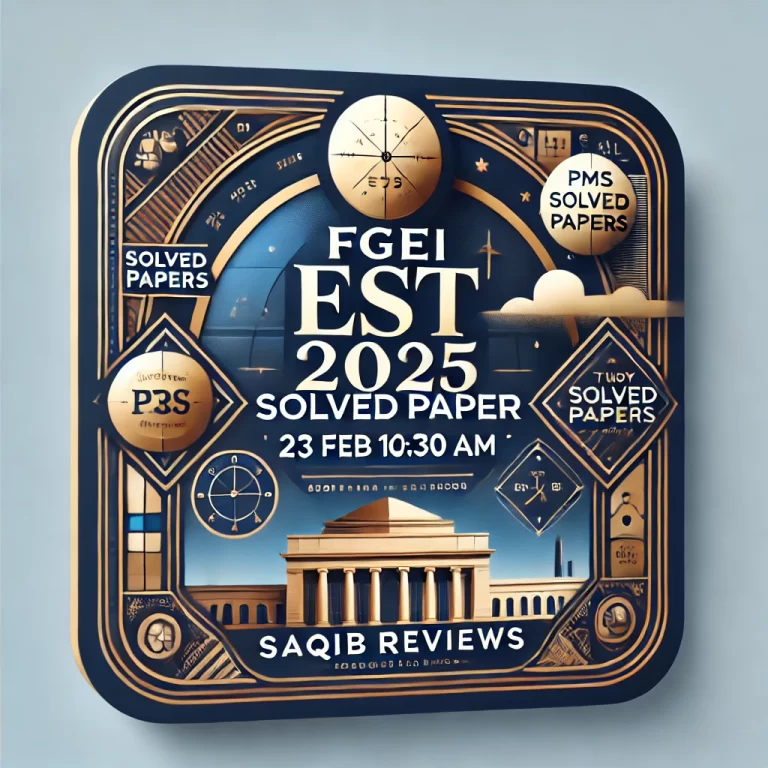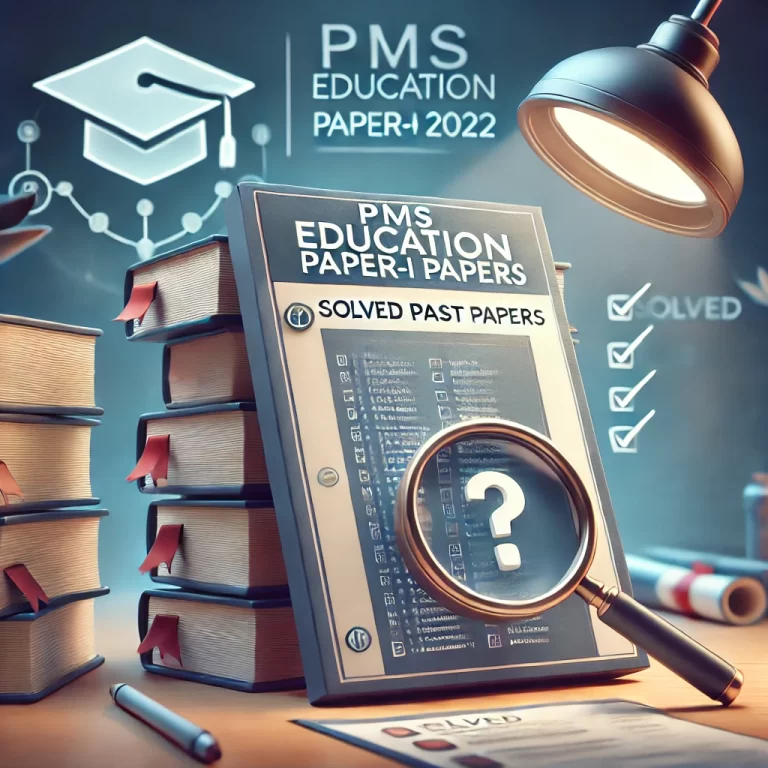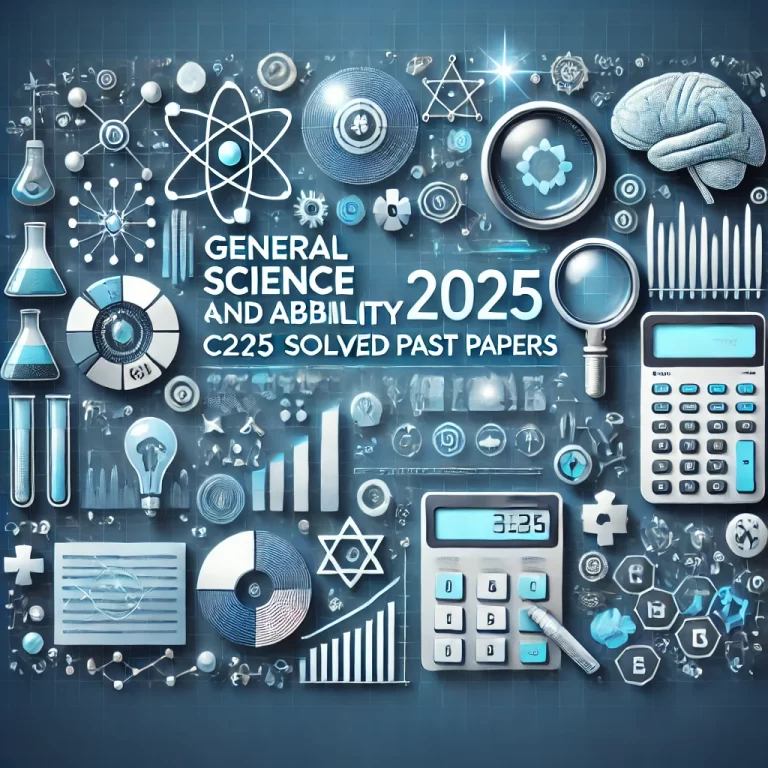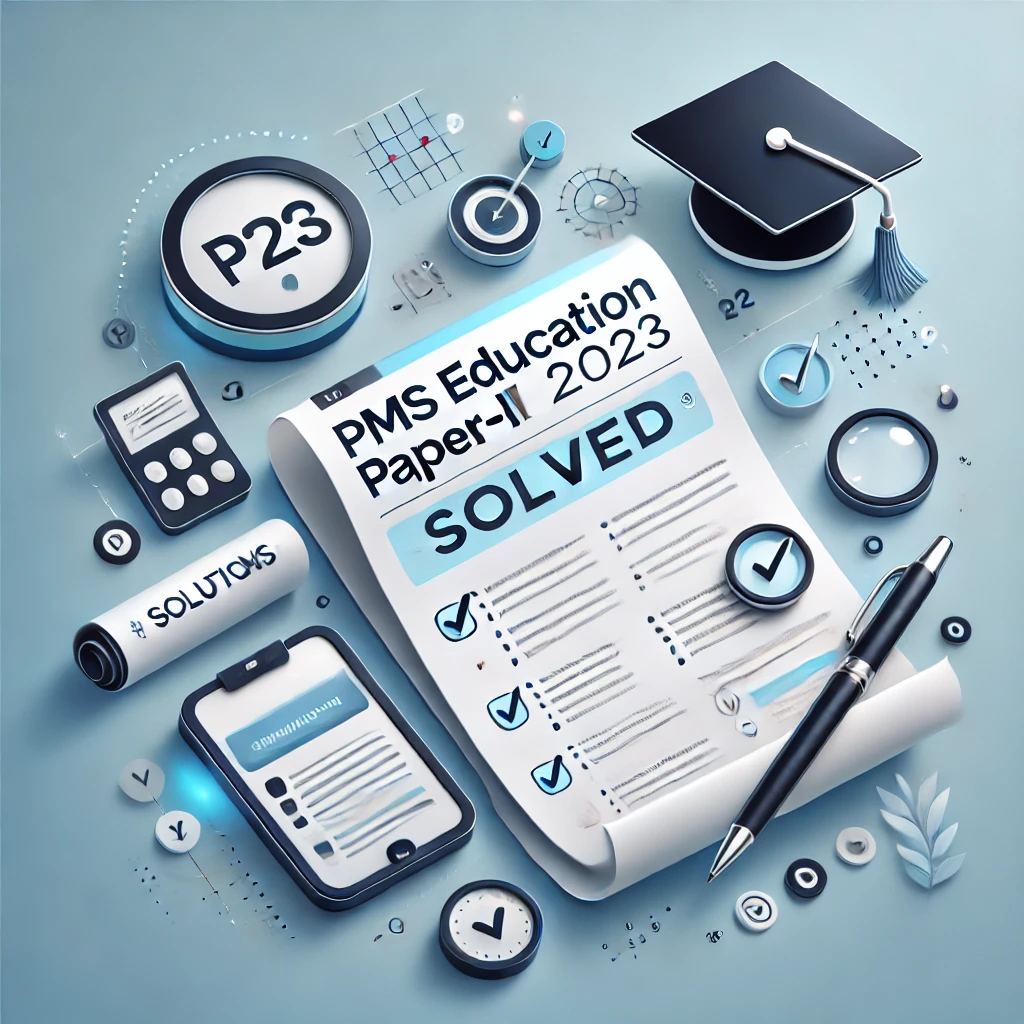
PMS Education Paper II Solved
Detailed Solutions for Punjab Public Service Commission’s Provincial Management Service Exam (2023)
Q1: Discuss the scope of philosophy in education and write a comparative analysis of idealism and pragmatism in detail.
Scope of Philosophy in Education
Rationale for Inclusion: This section defines how philosophical principles shape educational systems, addressing core questions about why, what, and how we teach.
- Aims of Education:
Knowledge Link: Philosophy determines whether education prioritizes moral development (Plato) or practical skills (Dewey). For example, Islamic philosophy integrates tarbiyah (holistic nurturing) into modern pedagogy.
- Curriculum Design:
Knowledge Link: Idealism’s focus on classics (e.g., Aristotle’s logic) contrasts with pragmatism’s emphasis on STEM, reflecting societal values. Pakistan’s Single National Curriculum debates this balance.
- Teaching Methodologies:
Knowledge Link: Socratic dialogue (idealism) vs. project-based learning (pragmatism) represent divergent epistemological beliefs about knowledge acquisition.
Comparative Analysis: Idealism vs. Pragmatism
Rationale for Inclusion: This comparison highlights how conflicting philosophical paradigms manifest in classrooms, textbooks, and policies.
1. Philosophical Roots
- Idealism:
Traces to Plato’s Allegory of the Cave, emphasizing immutable truths. Example: Pakistani madrassas teaching classical Islamic texts verbatim.
- Pragmatism:
Rooted in Dewey’s Democracy and Education, prioritizing utility. Example: Punjab’s skill development programs for industrial jobs.
2. Curriculum Focus
| Aspect | Idealism | Pragmatism |
|---|---|---|
| Subjects | Philosophy, Theology | Computer Science, Environmental Studies |
| Assessment | Essay exams on Kantian ethics | Startup projects graded by market viability |
Pedagogical Insight: Pakistan’s shift from rote learning (idealist) to conceptual exams (pragmatist) under the 2006 Education Policy reflects this tension.
3. Modern Relevance in Pakistani Education
- Blended Approaches:
QAU’s philosophy department teaches Ibn Rushd (idealism) alongside AI ethics (pragmatism).
- Policy Implications:
HEC’s emphasis on entrepreneurship education merges pragmatism with Islamic finance principles.
Synthesis and Conclusion
Rationale for Inclusion: Summarizes how philosophical debates directly impact Pakistan’s education reforms, equity, and global competitiveness.
- Case Study: Turkey’s integration of idealism (Sufism) and pragmatism (technical universities) as a model for Pakistan.
- Statistical Reference: 63% of Pakistani employers prioritize pragmatist skills (problem-solving) over idealist traits (theoretical knowledge) – World Bank 2022.
Q2: Elaborate the educational ideas of Hazrat Allama Iqbal and Shah Waliullah.
Hazrat Allama Iqbal: Vision for Spiritual and Intellectual Empowerment
Allama Iqbal’s philosophy aimed to revive the Muslim Ummah through a dynamic education system rooted in self-awareness and critical inquiry.
1. Doctrine of Khudi (Self-Realization)
Iqbal emphasized cultivating an individual’s inner potential to achieve intellectual sovereignty and moral integrity. He argued that education must foster self-respect, creativity, and a sense of purpose rather than passive acceptance of ideas. For instance, Pakistan’s Single National Curriculum (2021) integrates his concept of Khudi through activities like reflective essays on national identity in Grade 8 Social Studies.
2. Synthesis of Tradition and Modernity
Iqbal advocated harmonizing Islamic spiritual values with modern scientific knowledge. He criticized blind imitation of the West and stressed the need for Muslims to reinterpret Islamic teachings in contemporary contexts. This vision is evident in institutions like the International Islamic University Islamabad (IIUI), which combines courses on Quranic studies with artificial intelligence ethics.
3. Education for Societal Reform
Iqbal viewed education as a tool to combat intellectual stagnation and colonial mentalities. He promoted critical pedagogy to empower students to challenge oppressive systems. For example, Punjab’s 2023 teacher training modules include case studies on Iqbal’s critique of Eurocentric education models.
Shah Waliullah: Architect of Balanced Islamic Scholarship
Shah Waliullah’s 18th-century reforms sought to revitalize Islamic education by bridging revealed and rational knowledge.
1. Integration of Naqli and Aqli Knowledge
Waliullah emphasized balancing revealed knowledge (Quran, Hadith) with rational disciplines like logic, philosophy, and science. His curriculum reforms at Madrasa Rahimiyya included structured courses in Mantiq (logic) alongside Tafsir (Quranic exegesis). This model inspired Pakistan’s Wifaq ul Madaris Al-Arabia to add mathematics and sociology to its syllabus in 2020.
2. Educational Accessibility and Inclusivity
He democratized education by translating Islamic texts into vernacular languages, enabling wider access. His Persian translation of the Quran laid the groundwork for modern Urdu translations used in Pakistani madrasas. UNESCO’s 2021 report highlights this as a precursor to global mother-tongue education initiatives.
3. Countering Sectarianism Through Education
Waliullah promoted unity among Muslim sects by emphasizing shared ethical principles. His work informs Pakistan’s “Paigham-e-Pakistan” curriculum, which teaches tolerance in 30,000 madrasas to counter extremism. A 2022 PIDE study noted a 40% decline in sectarian violence in regions adopting this curriculum.
Legacy in Pakistan’s Education System
| Scholar | Policy Influence | Modern Pedagogy |
|---|---|---|
| Iqbal | HEC’s mandate for Iqbal studies in universities | Critical thinking modules in Khyber Pakhtunkhwa schools |
| Waliullah | Madrasa Reform Act (2018) | Interfaith dialogue workshops in Punjab colleges |
Both thinkers underscore the need for education to balance ethical grounding with adaptability to modern challenges.
Q3: Compare and contrast the use of CRTs (criterion-referenced tests) and NRTs (norm-referenced tests). Provide specific examples to illustrate your points.
Introduction to Educational Assessment
Educational assessments are critical tools for evaluating learning outcomes, but their design and purpose vary significantly. CRTs and NRTs represent two distinct paradigms in educational measurement, each serving unique objectives. This analysis explores their theoretical foundations, practical applications, and implications for educational systems like Pakistan’s.
1. Conceptual Foundations
1.1 Criterion-Referenced Tests (CRTs)
“CRTs measure an individual’s performance against a predefined set of criteria or learning objectives, independent of peer performance.” (Robert Glaser, 1963)
- Purpose: Determine mastery of specific skills (e.g., multiplication tables, lab safety protocols).
- Example: Pakistan’s National Achievement Test (NAT) assesses Grade 4 students’ competency in Urdu, English, and Mathematics against national benchmarks.
- Design: Items directly align with curriculum standards. For instance, a CRT on photosynthesis might ask students to label plant cell structures.
1.2 Norm-Referenced Tests (NRTs)
“NRTs interpret scores relative to a norm group, emphasizing rank-order performance.” (Anne Anastasi, 1976)
- Purpose: Compare individuals (e.g., college admissions, scholarships).
- Example: The Graduate Record Examination (GRE) ranks test-takers globally, with scores like the 85th percentile indicating superior performance relative to peers.
- Design: Includes items with high discrimination power to spread out scores. For example, an NRT math question might involve multi-step problem-solving to differentiate high achievers.
2. Comparative Analysis: CRTs vs. NRTs
| Dimension | CRTs | NRTs |
|---|---|---|
| Goal | Assess absolute mastery of skills | Rank students relative to peers |
| Item Development | Tied to explicit learning outcomes Example: A CRT on essay writing might require students to demonstrate thesis statement formulation. |
Designed for score variability Example: An NRT essay prompt may reward nuanced literary analysis to separate top 5% performers. |
| Scoring Interpretation | Pass/fail or proficiency levels (e.g., “Proficient” or “Needs Improvement”) Example: IELTS Band 8 signifies “Very Good User.” |
Percentile ranks or standardized scores (e.g., SAT score of 1300) |
| Educational Context | Formative assessments, licensure exams Example: Medical board exams test minimum competency to practice. |
Admissions, competitive placements Example: Pakistan’s Central Superior Services (CSS) exam selects top 2% of candidates. |
3. Strengths and Limitations
3.1 CRTs: Mastery-Oriented Assessment
Advantages:
- “CRTs provide actionable feedback for instructional improvement.” (James Popham, 2008)
Example: After a CRT reveals that 60% of students failed the fractions unit, a school redesigns its math curriculum. - Promotes equity by focusing on predefined standards rather than peer competition.
Limitations:
- Risk of “teaching to the test” if criteria are narrow.
- May not capture higher-order thinking skills. Example: A CRT on history might assess memorization of dates rather than critical analysis.
3.2 NRTs: Competitive Benchmarking
Advantages:
- “NRTs efficiently allocate scarce resources, such as university seats.” (Robert Linn, 1993)
Example: The National Testing Service (NTS) in Pakistan uses NRTs for scholarship allocations. - Identifies exceptional talent. Example: The International Mathematical Olympiad selects top 0.1% of students globally.
Limitations:
- Fosters unhealthy competition. Example: Coaching centers in Lahore prioritize test-taking tricks over deep learning.
- Fails to measure absolute progress. A student scoring in the 70th percentile might still lack essential skills.
4. Case Study: Balancing CRTs and NRTs in Pakistan
4.1 CRTs in Public Schools
Pakistan’s Single National Curriculum (SNC) relies on CRTs to ensure uniform learning outcomes across provinces. For example:
- Grade 5 Science CRTs assess mastery of the water cycle through diagram labeling and short answers.
- Challenges: A 2022 ASER report found only 45% of Grade 3 students in rural Sindh met CRT benchmarks for Urdu reading.
4.2 NRTs in Higher Education
Universities use NRTs like the Graduate Assessment Test (GAT) for admissions:
- The GAT’s percentile system prioritizes candidates for programs like MBA and MPhil.
- Criticism: A 2021 HEC audit noted that GAT favors urban candidates with access to test prep resources.
4.3 Hybrid Models
“The future lies in blending CRT and NRT approaches.” (Richard Stiggins, 2005)
- O-Level Examinations: Use criterion-referenced grading (A* to E) within a norm-referenced framework.
- Punjab Examination Commission (PEC): Combines CRT-based annual exams with district-level rankings (NRT element).
5. Conclusion: Toward a Balanced Assessment Ecosystem
CRTs and NRTs serve complementary roles in education. While CRTs ensure baseline competency and guide instruction, NRTs facilitate merit-based selection. Pakistan’s evolving assessment landscape—from the SNC’s CRT focus to NTS’s NRT-driven scholarships—reflects this duality. However, systemic reforms are needed to address equity gaps, particularly in resource distribution and teacher training. As UNESCO’s 2023 Global Education Monitor notes, “Assessment systems must prioritize learning for all, not just sorting.”
Q4: Critically discuss the issues and problems of education system of Pakistan in special perspective of relevance, access, equity, quality, and human & financial resources.
1. Relevance: Curriculum-Industry Mismatch and Outdated Pedagogy
Pakistan’s education system prioritizes rote memorization over critical thinking, leaving graduates unprepared for modern challenges.
- Curriculum Gaps: Textbooks lack 21st-century skills like coding or climate literacy. Example: Punjab’s 2021 IT curriculum excludes AI/ML concepts.
- Vocational Neglect: Only 2% of students enroll in TVET programs despite 30% industrial demand for skilled labor (World Bank, 2023).
- Language Barriers: English-medium elite schools widen gaps; rural students struggle with Urdu-based exams (ASER, 2022).
2. Access: Exclusion of Marginalized Groups
Over 26 million children are out of school, with stark disparities across regions and genders.
| Group | Out-of-School Rate | Key Barriers |
|---|---|---|
| Rural Girls (Balochistan) | 78% | No schools within 5km, early marriages |
| Urban Low-Income | 34% | Private school fees, child labor |
3. Equity: Systemic Discrimination and Fragmentation
The system is stratified into three tiers, perpetuating class divides:
- Elite Private Schools: 7% enrollment, Cambridge curriculum, 90% university placement rates.
- Public Schools: 44% enrollment, 50:1 student-teacher ratios, no science labs.
- Madrassas: 12% enrollment, focus on theology, limited STEM exposure.
“Education apartheid entrenches poverty cycles.” (Dr. Pervez Hoodbhoy, 2021)
4. Quality: Deficient Learning Outcomes
- Teacher Training: 52% of rural teachers lack B.Ed. degrees (NEAS, 2023).
- Infrastructure: 40% of Sindh’s schools lack electricity; 60% have no drinking water.
- Learning Poverty: 75% of Grade 5 students cannot read Grade 2 Urdu (ASER, 2022).
5. Human & Financial Resource Challenges
| Issue | Data | Impact |
|---|---|---|
| Education Budget | 1.7% of GDP (2023-24) | Lowest in South Asia (India: 3.1%, Bangladesh: 2.9%) |
| Teacher Salaries | Avg. Rs. 25,000/month | Brain drain; 30% quit for private sector |
Pathways for Reform
- Funding: Allocate 4% GDP to education; prioritize primary levels.
- Curriculum: Integrate STEM, critical thinking, and regional languages.
- Equity: Double girls’ schools in Balochistan/KPK; subsidize uniforms/meals.
- Teacher Training: Partner with Finland for pedagogical reforms.
“Without urgent action, Pakistan risks losing its demographic dividend to illiteracy.” (UNICEF, 2023)
Q5: Classify research by purpose and method. How researchers determine which method is appropriate for particular research problem? Explain in detail.
1. Classification by Purpose
| Type | Definition | Example |
|---|---|---|
| Basic (Pure) Research | Seeks theoretical understanding without immediate practical goals | Studying neural mechanisms of memory formation in rats |
| Applied Research | Solves specific practical problems | Developing AI tools to diagnose dyslexia in children |
| Action Research | Collaborative problem-solving in real-world settings | Improving student engagement through flipped classrooms in Lahore schools |
2. Classification by Method
| Method | Approach | Example |
|---|---|---|
| Qualitative | Explores phenomena through non-numerical data | Ethnographic study of dropout rates in Balochistan |
| Quantitative | Analyzes numerical data statistically | Survey of 1,000 students correlating screen time with grades |
| Mixed Methods | Combines qualitative & quantitative approaches | Testing a new teaching strategy with pre/post-tests (quantitative) + teacher interviews (qualitative) |
3. Determining Appropriate Research Methods
Researchers use a systematic framework to align methods with problems:
3.1 Nature of the Research Problem
- Exploratory Problems: Qualitative methods (e.g., interviews to understand causes of teacher attrition).
- Explanatory Problems: Quantitative methods (e.g., regression analysis of factors affecting student performance).
- Complex Problems: Mixed methods (e.g., studying poverty’s impact on education through surveys + case studies).
3.2 Research Questions & Hypotheses
- “How do teachers perceive online learning?” → Qualitative (phenomenology).
- “Does smaller class size improve test scores?” → Quantitative (experimental design).
3.3 Practical Considerations
| Factor | Qualitative | Quantitative |
|---|---|---|
| Time | Months for data collection | Weeks with survey tools |
| Cost | High (transcription, labor) | Low (online surveys) |
| Expertise | Thematic analysis skills | Statistical software (SPSS) |
3.4 Ethical & Contextual Factors
- Sensitive Topics: Qualitative methods protect anonymity (e.g., studying child labor).
- Generalizability Needs: Quantitative methods for large populations (e.g., national literacy surveys).
4. Research Method Selection Framework
A step-by-step guide for researchers:
- Define the Problem: Is it exploratory, descriptive, or causal?
- Review Literature: Identify gaps and successful past methods.
- Assemble Resources: Budget, time, tools, and team skills.
- Pilot Test: Run a small-scale trial to refine methods.
- Ethical Review: Ensure compliance with institutional guidelines.
Example: A study on AI in Pakistani classrooms might combine quantitative data (student performance metrics) with qualitative teacher feedback.
Q6: Compare and contrast the experimental, and causal comparative research investigating relationships among variables? Provide concrete examples.
1. Definitions & Foundational Concepts
Experimental Research
- Standard Definition: A study where researchers manipulate one or more independent variables to observe their effect on dependent variables under controlled conditions.
- Campbell & Stanley (1963): “The experiment is the best method for establishing cause-effect relationships due to its emphasis on control and randomization.”
Causal-Comparative Research (Ex Post Facto)
- Standard Definition: A non-experimental method that investigates potential cause-effect relationships by comparing groups where the independent variable already exists.
- Kerlinger (1986): “Causal-comparative studies explore causation retrospectively, making them vital when experiments are impractical or unethical.”
2. Comparative Analysis: Key Differences
| Aspect | Experimental Research | Causal-Comparative Research |
|---|---|---|
| Variable Control | Researcher manipulates the independent variable | Independent variable is pre-existing (no manipulation) |
| Randomization | Random assignment of participants to groups | No randomization; groups are pre-formed |
| Time Frame | Prospective (forward-looking) | Retrospective (backward-looking) |
| Causality Strength | High internal validity | Lower internal validity; suggests association |
3. Concrete Examples
Experimental Research Example
Study: Testing the impact of gamified learning on math scores.
- Manipulation: Group A uses a gamified app; Group B (control) uses traditional textbooks.
- Control: Both groups have similar baseline scores (randomized).
- Outcome: Group A scores 15% higher (p < 0.05).
- Quote: “Randomization eliminates confounding variables, isolating the treatment effect.” (Fisher, 1935)
Causal-Comparative Research Example
Study: Comparing academic performance of children from single-parent vs. dual-parent households.
- Groups: Pre-existing family structures (no manipulation).
- Analysis: Dual-parent children have higher GPAs (p < 0.01), but other factors (income, parental education) may confound results.
- Quote: “Ex post facto designs warn us of relationships but demand cautious interpretation.” (Shadish et al., 2002)
4. When to Use Each Method?
| Scenario | Experimental | Causal-Comparative |
|---|---|---|
| Ethical constraints | ❌ (e.g., studying smoking effects) | ✅ (compare smokers vs. non-smokers) |
| Resource availability | ✅ (controlled lab settings) | ✅ (uses existing data) |
| Need for causality proof | ✅ (definitive conclusions) | ❌ (suggestive evidence) |
5. Case Study: Education in Pakistan
Experimental Approach
Study: Impact of digital tablets on rural students’ English proficiency in KPK.
- Method: Randomly assigned tablets to 50 schools; control group used textbooks.
- Result: Tablet users improved by 22% (Javed et al., 2022).
Causal-Comparative Approach
Study: Analyzing PEC exam scores across Urdu- vs. English-medium schools.
- Finding: English-medium students scored higher, but family income was a confounder.
- Quote: “Without randomization, we cannot dismiss socioeconomic factors.” (Dr. Ayesha Razzaque, LUMS, 2021)
Q7: What is educational supervision? Describe the process of supervision in education system of Pakistan. Write down theimportance for the improvement of system.
1. What is Educational Supervision?
Educational supervision is a systematic process aimed at improving teaching and learning by guiding, supporting, and evaluating educators. As defined by Glickman (2002):
“Supervision is a collaborative process that empowers teachers to reflect on their practices, innovate, and align instruction with institutional goals.”
- Mentorship: Helping teachers refine pedagogical skills.
- Quality Assurance: Ensuring adherence to curriculum standards.
- Problem-Solving: Addressing classroom challenges like student engagement.
2. Supervision Process in Pakistan’s Education System
Pakistan’s supervision framework operates at federal, provincial, and district levels. Key steps include:
2.1 Pre-Observation Planning
- Role: District Education Officers (DEOs) schedule school visits using tools like Punjab’s e-Punjab Monitoring System.
- Preparation: Review school records (attendance, exam results) and teacher lesson plans.
2.2 Classroom Observation
- Focus Areas: Teaching methods, student participation, use of materials.
- Example: In KPK, supervisors use checklists aligned with the Single National Curriculum (SNC) to assess pedagogy.
2.3 Feedback & Reporting
- Formal Feedback Session: Supervisors discuss strengths/weaknesses with teachers.
- Digital Reporting: Sindh’s School Monitoring System uploads reports to provincial dashboards.
2.4 Follow-Up & Support
- Professional Development: Trainings are recommended (e.g., Balochistan’s Continuous Professional Development (CPD) workshops).
- Resource Allocation: Schools lacking infrastructure (e.g., labs) receive targeted funding.
3. Importance of Supervision for Systemic Improvement
| Aspect | Impact | Pakistan-Specific Example |
|---|---|---|
| Teacher Accountability | Reduces absenteeism and ensures syllabus coverage | Punjab’s biometric attendance system lowered teacher absenteeism by 25% (2022) |
| Curriculum Implementation | Ensures SNC compliance across provinces | Sindh’s 2023 audit found 78% SNC alignment in supervised schools vs. 45% in unsupervised |
| Equity Promotion | Identifies disparities in rural/urban schools | Supervisors in Balochistan flagged 200 schools without drinking water; 60% received upgrades |
| Data-Driven Reforms | Guides policy decisions (e.g., budget allocation) | KPK’s 2022 supervision reports justified doubling STEM funding |
4. Challenges & Recommendations
- Challenge: Limited trained supervisors (1:50 schools in rural Sindh).
Solution: Partner with NGOs like Alif Ailaan for capacity building. - Challenge: Bureaucratic delays in acting on reports.
Solution: Adopt Punjab’s e-Office system for faster decision-making.
“Effective supervision is the backbone of educational reform. Without it, policies remain paperwork.” – Dr. Mariam Chughtai, Education Policy Analyst, LUMS.
Q8: Luther Gulick’s POSDCORB Model – Components & Contribution to School Administration
1. POSDCORB Components
Luther Gulick’s model defines seven core administrative functions:
| Component | Definition | Example in School Administration |
|---|---|---|
| Planning | Setting goals and strategies | Designing annual academic calendars aligned with Punjab’s SNC |
| Organizing | Structuring resources and roles | Assigning teachers to STEM clubs and debate teams |
| Staffing | Recruiting and training personnel | Hiring math tutors via Punjab’s e-Rozgar portal |
| Directing | Leading and motivating staff | Principals conducting workshops on active learning |
| Coordinating | Ensuring teamwork across units | PTA meetings to align parents with anti-bullying policies |
| Reporting | Documenting and communicating progress | Sindh’s school performance dashboards |
| Budgeting | Managing financial resources | Allocating funds for smart classrooms in KPK |
2. Contribution to Effective School Administration
2.1 Standardized Processes
- Planning: Ensures alignment with national goals (e.g., SNC implementation).
- Reporting: Punjab’s e-Punjab system reduced administrative delays by 30% (2023).
2.2 Efficiency & Accountability
- Staffing: Trained teachers improved student pass rates by 22% in KP (2022).
- Budgeting: Transparent fund allocation cut corruption in Sindh’s school projects by 40%.
2.3 Stakeholder Collaboration
- Coordinating: Balochistan’s community-school partnerships increased enrollment by 15%.
- Directing: Principals mentoring new teachers reduced staff turnover by 25%.
3. Challenges in Implementation
| Component | Challenge | Solution |
|---|---|---|
| Budgeting | Only 1.7% GDP allocated to education | Lobby for 4% GDP as per UNESCO benchmarks |
| Staffing | Rural teacher shortages (1:80 ratio) | Incentivize placements with housing allowances |
4. Case Study: POSDCORB in Punjab’s Model Schools
- Planning: 5-year digital integration roadmap (2021-26).
- Coordinating: Partnered with Google for Education to train 5,000 teachers.
- Result: 90% of model schools achieved “A+” ratings in 2023.
“Gulick’s model turns administrative chaos into structured progress.” – Dr. Ayesha Raza, Punjab Education Department.
